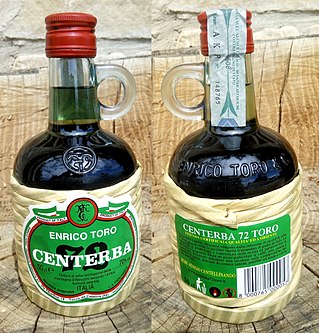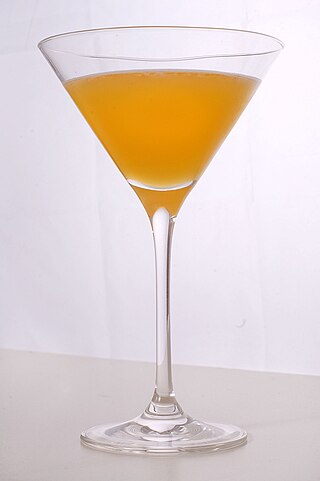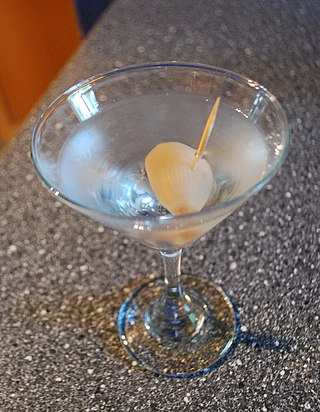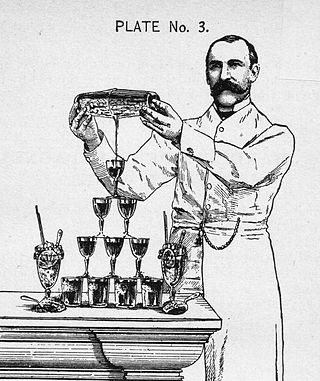
A gin and tonic is a highball cocktail made with gin and tonic water poured over a large amount of ice. The ratio of gin to tonic varies according to taste, strength of the gin, other drink mixers being added, etc., with most recipes calling for a ratio between 1:1 and 1:3. It is usually garnished with a slice or wedge of lime. To preserve effervescence, the tonic can be poured down a bar spoon. The ice cools the gin, dulling the effect of the alcohol in the mouth and making the drink more pleasant and refreshing to taste.

Vermouth is an aromatized fortified wine, flavoured with various botanicals and sometimes colored. The modern versions of the beverage were first produced in the mid to late 18th century in Turin, Italy. While vermouth was traditionally used for medicinal purposes, it was later served as an apéritif, with fashionable cafés in Turin serving it to guests around the clock. In the late 19th century, it became popular with bartenders as a key ingredient for cocktails, such as the martini, the Manhattan, the Rob Roy, and the Negroni. In addition to being consumed as an aperitif or cocktail ingredient, vermouth is sometimes used as an alternative to white wine in cooking.

The martini is a cocktail made with gin and vermouth, and garnished with an olive or a lemon twist. Over the years, the martini has become one of the best-known mixed alcoholic beverages. A popular variation, the vodka martini, uses vodka instead of gin for the cocktail's base spirit.

The hanky panky is a cocktail made from gin, sweet vermouth, and Fernet-Branca. It is a variation on the sweet martini, or Martinez, made distinctive by the Fernet-Branca, a bitter Italian digestivo. It was created by Ada "Coley" Coleman, head bartender at the Savoy Hotel, London.

Centerbe[ˌtʃɛnˈtɛrbe] or Centerba, is a liqueur made by aromatic herbs commonly found on Mount Majella. It is a typical abruzzese liquor in central Italy and it's made on a base of 70% alcohol. The liqueur comes in two strengths: strong and mild. The strong centerba is widely used as digestif after-meals and has antiseptic properties. It was originally manufactured by Beniamino Toro in Tocco da Casauria in 1817.

Noilly Prat is a brand of vermouth from France, owned by the Italian company Martini & Rossi, which is a subsidiary of Bacardi. "White" Noilly Prat is the archetype of dry, straw-coloured French vermouth. Noilly Prat now makes Red and Ambre vermouths as well, introduced in the 1960s and 1980s, but they are less widely known. Noilly Prat Dry is 18% alcohol by volume. The Noilly Prat company is based in Marseillan, in the Hérault département of southern France. Joseph Noilly, a herbalist, developed the first formula in 1813, 50 years before the now archetypal vermouth, Martini.

The Bronx is a cocktail. It is essentially a Perfect Martini with orange juice added. It was ranked number three in "The World's 10 Most Famous Cocktails in 1934" behind the Martini (#1) and the Manhattan (#2). In the 1934 movie "The Thin Man", the lead actor compared the methods for shaking the Manhattan, the Bronx and the Martini.

The Fine Art of Mixing Drinks is a book about cocktails by David A. Embury, first published in 1948. The book is noteworthy for its witty, highly opinionated and conversational tone, as well as its categorization of cocktails into two main types: aromatic and sour; its categorization of ingredients into three categories: the base, modifying agents, and special flavorings and coloring agents; and its 1:2:8 ratio for sour type cocktails.

The Gibson is a mixed drink made with gin and dry vermouth, and often garnished with a pickled onion. In its modern incarnation, it is considered a cousin of the ubiquitous martini, distinguished mostly by garnishing with an onion instead of an olive. But the earliest recipes for a Gibson – including the first known recipe published in 1908 – are differentiated more by how they treat the addition of bitters.

A sea breeze is a cocktail containing vodka with cranberry juice and grapefruit juice. The cocktail is usually consumed during summer months. The drink may be shaken in order to create a foamy surface. It is considered an IBA Official Cocktail.

A Clover Club cocktail is a shaken cocktail consisting of gin, lemon juice, raspberry syrup, and egg white. The egg white acts as an emulsifier, forming the drink's characteristic foamy head.
An aromatised wine is a fortified wine or mistelle that has been flavoured with herbs, spices, fruit or other natural flavourings.

Harry Johnson was an American bartender who owned and operated saloons across the US in the late 19th century and the early 20th century. He is best known for the New and Improved Bartenders' Manual, an influential book that contained many original cocktail recipes, as well as the first written recipes of such cocktails as the marguerite and a version of the martini. Perhaps even more importantly, it was the first book to offer bar management instructions. Johnson opened the first ever consulting agency for bar management. Imbibe magazine has called him one of the most influential cocktail personalities of the last 100 years, and he has been called "the father of professional bartending".
The Blackthorn is an Irish whiskey or sloe gin based cocktail. Both versions emerged in the late 19th and early 20th century.

The Martinez is a classic cocktail that is widely regarded as the direct precursor to the Martini. It serves as the basis for many modern cocktails, and several different versions of the original exist. These are generally distinguished by the accompaniment of either Maraschino or Curacao, as well as differences in gin or bitters.
The Cat's Eye is a classic gin-based cocktail that appears in The Savoy Cocktail Book. It's made with lemonade, cointreau, vermouth and a splash of kirsch. The original recipe is intended for a 6 person batch. Another version of the drink is made with gin, vermouth and chartreuse, garnished with orange peel.

A Nick & Nora glass is a stemmed glass with an inverted bowl, mainly used to serve straight-up cocktails. The glass is similar to a cocktail glass or martini glass.

The craft cocktail movement is a social movement spurred by the cocktail renaissance, a period of time in the 21st century characterized by a revival and re-prioritization of traditional recipes and methods in the bar industry, especially in the United States. The renaissance spanned from 2004 into the late 2010s. By 2017, high-quality ingredients, techniques, and liquors began to be ubiquitous in bars across the United States, leading writers to declare the renaissance over.
















